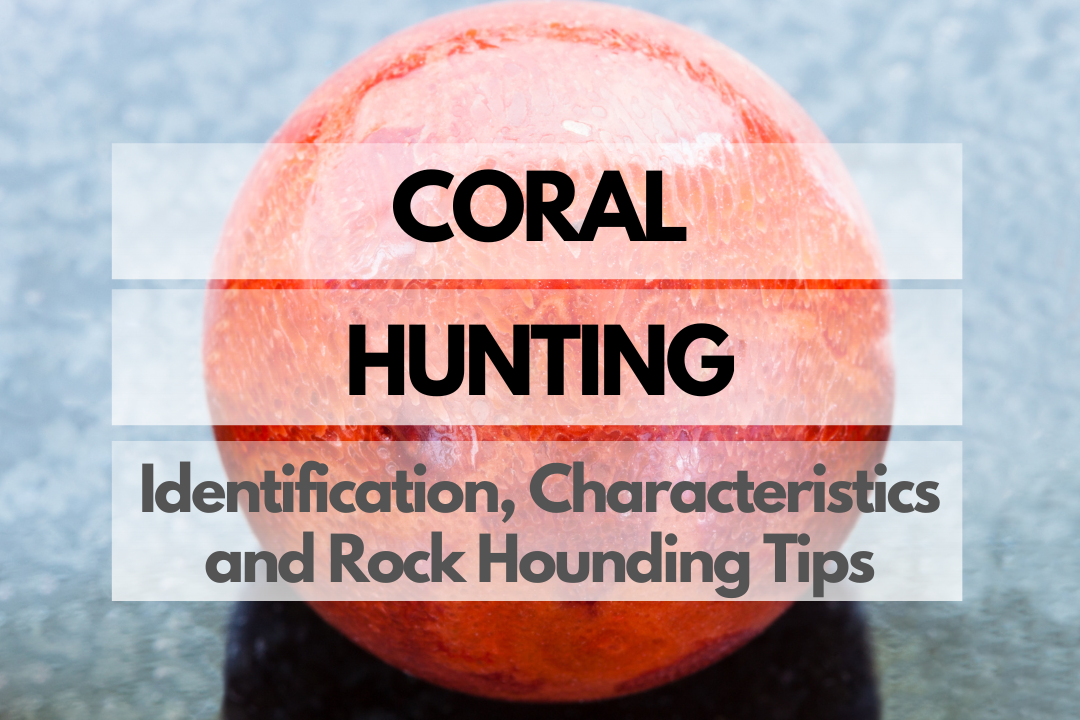Embark on an exciting journey to discover the beauty and wonder of coral! These unique and captivating organic gems have captured the imagination of rock hounds and collectors for centuries. In this article, we’ll explore the history, identification, characteristics, and tips for hunting and collecting coral specimens.
History & Origin of Coral
Coral has a rich and fascinating history, dating back to ancient times. Highly valued for its beauty and rarity, coral has been used in jewelry, art, and religious objects throughout various cultures. The name “coral” is derived from the Greek word “korallion,” which likely has its roots in the Hebrew word “goral,” meaning small pebble or stone.
Historically, coral has held significant cultural and spiritual importance in many societies. In ancient Egypt, it was believed to protect against evil spirits and provide strength to the wearer. The Romans and Greeks also valued coral, associating it with protection, luck, and wisdom. In Native American cultures, coral was often used in combination with turquoise and silver to create stunning jewelry and ceremonial objects.
Coral Identification & Physical Properties
To identify and appreciate the unique characteristics of coral, it’s essential to understand its physical properties. The following table provides an overview of coral’s key attributes:
| Physical Property | Description |
|---|---|
| Chemical Composition | CaCO3 (calcium carbonate) |
| Formation | Formed by marine organisms called coral polyps, which secrete calcium carbonate to create a hard skeleton |
| Luster | Vitreous to waxy, often polished to enhance appearance |
| Transparency | Opaque to translucent |
| Fracture | Conchoidal to splintery |
Coral Colors
Coral exhibits a diverse range of colors, including red, pink, white, blue, black, and orange. The most highly sought-after color is a vibrant red, known as “oxblood” coral. Coloration in coral is primarily influenced by the presence of pigments and the type of algae that live symbiotically within the coral polyps.
Coral Hardness
Coral has a relatively low hardness, ranging from 3 to 4 on the Mohs scale. This makes it a relatively soft material, which can be easily scratched or damaged if not handled with care. Coral’s hardness can vary depending on its composition and the specific type of coral.
Coral Types
Red Coral (Corallium rubrum)
Red coral, also known as precious coral or Mediterranean coral, is highly prized for its vibrant red and pink hues. It is primarily found in the Mediterranean Sea and is considered the most valuable variety of coral.
Black Coral (Antipatharia)
Black coral is a deep-sea coral known for its black, brown, or dark green color and unique, tree-like branching structure. It is often used in jewelry and has been designated as the official state gem of Hawaii.
Blue Coral (Heliopora coerulea)
Blue coral is a rare and beautiful variety known for its distinct blue color. It is formed by a unique species of coral polyps that secrete a blue-colored skeleton, which is later polished to bring out its vibrant hue.
White Coral (Balanophyllia elegans)
White coral, also known as ivory coral or angel skin coral, features a creamy white to pale pink color. It is often used in jewelry and carved into intricate shapes and designs.
Coral Uses
Coral has been used for various purposes throughout history, including:
- Jewelry: Coral’s natural beauty and vibrant colors make it a popular choice for rings, necklaces, earrings, and bracelets.
- Carvings: Coral’s softness allows it to be carved into intricate shapes and designs, making it a popular material for decorative objects and religious artifacts.
- Aquarium decorations: Natural or artificial coral is often used tocreate visually appealing and realistic environments in marine aquariums.
- Medicine: In some traditional cultures, coral has been used as a remedy for various ailments, such as digestive issues and skin conditions.
How Much Is Coral Worth?
The value of coral can vary significantly depending on factors such as color, rarity, size, and overall quality. Price ranges can be anywhere from a few dollars for small, lower-quality pieces, to several thousand dollars for large, high-quality specimens, especially those in the highly coveted oxblood red color. It’s important to note that the trade of certain coral varieties, such as red and black coral, is regulated to protect these species from over-harvesting. Always ensure that any coral you purchase has been sourced ethically and legally.
Coral Rock Hounding Tips
Ready to embark on your coral hunting adventure? Here are some essential tips and tricks for a successful and enjoyable experience in the field.
Essential Tools and Equipment
Equip yourself with the right tools to make your coral hunting experience more efficient and enjoyable. Some essential items include:
- Rock hammer: A versatile tool for breaking rocks and extracting specimens.
- Chisel: Useful for splitting rocks and prying out coral samples.
- Protective eyewear: Safety goggles are crucial for protecting your eyes from flying debris when using a hammer and chisel.
- Gloves: A good pair of gloves will protect your hands from sharp rocks and provide better grip.
- Brush: A small brush can help clean dirt and dust off your coral finds.
- Collection bags or containers: Keep your finds organized and protected during your hunt.
- GPS or a map: Ensure you know your location and don’t get lost while exploring new places.
Safety Tips
Keep safety in mind during your coral hunting adventures. Here are some essential safety tips:
- Never go rock hounding alone. Bring a buddy or join a group to ensure safety and assistance if needed.
- Stay aware of your surroundings, and watch out for hazards such as slippery or unstable surfaces, sharp rocks, or wildlife.
- Wear appropriate clothing and footwear for the terrain you’ll be exploring. Protective gear such as a hat, sunscreen, and insect repellent is also recommended.
- Stay hydrated and bring plenty of water, especially when hunting in hot or remote locations.
- Know your limits and don’t overexert yourself. Take breaks when needed and pace yourself.
Coral Hunting: Where to Find Coral
Coral can be found in various regions worldwide, with some areas being more famous for their coral deposits than others. The following table highlights some notable coral hunting locations:
| Site/Area | City/State/Country |
|---|---|
| Costa Smeralda | Sardinia, Italy |
| Alghero | Sardinia, Italy |
| Provence-Alpes-Côte d’Azur | France |
| Nosy Be | Madagascar |
| Great Barrier Reef | Queensland, Australia |
| Florida Keys | Florida, USA |
| Hawaii | Hawaii, USA |
Caring For Your Coral
Proper care is essential to maintain the beauty and value of your coral specimens. Here are some tips for preserving your coral:
- Store your coral in a dry, cool place to prevent damage from heat and humidity.
- Avoid exposing coral to harsh chemicals or cleaning agents, as they can damage the delicate structure.
- Regularly clean your coral with a soft brush and water to remove dust and dirt. Allow it to air dry before storing.
- If your coral becomes scratched or loses its luster, it can be polished using a soft cloth and a gentle polishing compound.
Additional Resources
Expand your knowledge and connect with fellow coral enthusiasts by exploring these helpful resources:
- Government resources: NOAA and NOAA Fisheries offer valuable information on coral conservation and regulation.
- Scientific articles: Search for coral research articles on databases like USGS Publications Warehouse or ScienceDirect.
- Forums/Communities: Connectwith like-minded coral enthusiasts on forums like Mindat.org or The Fossil Forum.
- Books: Check out popular books on coral identification and rock hounding, such as “Coral Reefs: A Guide to the Common Invertebrates and Fishes” by Charles Delbeek and Julian Sprung or “The Rockhound’s Handbook” by James R. Mitchell.
Additional Coral FAQs
Here are some frequently asked questions about coral:
What are the benefits of coral?
Aside from their aesthetic beauty, coral reefs are essential to marine ecosystems, providing habitat and shelter for a vast array of marine life. They also act as natural barriers that protect coastlines from erosion and storm damage.
Do coral have any healing properties?
While some believe that coral possesses healing properties, there is limited scientific evidence to support these claims. However, the calcium carbonate content in some types of coral has been used in traditional medicines and supplements.
Do coral have any spiritual meaning?
In various cultures, coral is believed to hold spiritual significance, symbolizing protection, transformation, and connections with the sea. Different colors of coral may also be associated with specific meanings, such as red coral being linked to passion and vitality.
Do I need a permit to go coral hunting?
In certain areas, permits may be required for the collection and removal of coral. Regulations vary depending on the location and the specific type of coral. For more information on permits and regulations in the United States, visit the NOAA Fisheries Coral Conservation website.
Closing Thoughts
Now that you’re equipped with all the knowledge and tips you need, it’s time to embark on your coral rock hounding adventure! Remember to stay safe, respect the environment, and enjoy the thrill of discovering these vibrant and unique treasures from the sea. Happy hunting!

